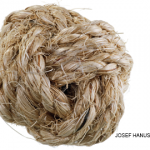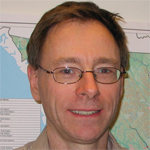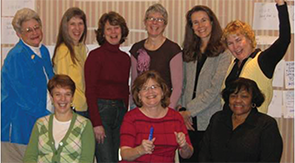
A past hardworking Annual Meeting Program Subcommittee.
How do you tell a story 50 years in the making? How do you capture 50 years of achievements, moments, personal and professional relationships, and careers shaped? How do you define the exact moment collaborative and integrated care teams became the rule—not the exception—in rheumatology?
To journey through the milestones that have led to the Association of Rheumatology Health Professionals’ (ARHP’s) Golden Anniversary, it’s best to go directly to the people who were there—those who, along with their fellow members, built the organization that today serves more than 1,300 healthcare professionals in rheumatology.
This summer, several past presidents—whose presidencies ranged from the early 1970s to 2015—reflected on the ARHP’s 50 years of service to its members. Although each president recalled various memories and organizational achievements, they all noted similar themes that have set the ARHP apart for the past 50 years: innovative, member-centric education; an inclusive and welcoming environment; opportunities for personal and professional development; and the ARHP’s unique, integrated structure.
An Organizational Structure that Sets a Standard
Throughout its first 50 years, the ARHP has undergone many changes and enjoyed steady growth. One change that cemented the Association’s commitment to integration and collaboration between its members and the rheumatologists with whom they regularly collaborate was the decision to merge with the American College of Rheumatology in 1994. With this merger came integrated committees and cross representation on both governing bodies.
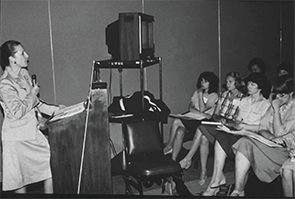
An ARHP Annual Meeting in the early 1980s.
Laura Robbins, DSW (ARHP president, 1993–1994), was president at the time of the merger and recalled the hard work by both the ARHP and the ACR to ensure success. “There were concerns and fears about the ARHP losing its identity and autonomy, and we collectively worked with the ACR’s leadership to build bridges,” she says. “I really think we set the groundwork for a new environment where both groups could help and learn from each other.”
For Robert W. Richardson, PT, MEd, FAPTA (ARHP president, 1976–1977), this structure is a hallmark of the ARHP that is envied by many other disciplines and organizations. “Inclusiveness is an opportunity to share expertise and ideas,” he explains. “We are all good at what we do, but not always good at what other people do. An integrated structure was a different approach from what people were used to seeing at that time, but it has served both the ARHP and the ACR well.”
Further affirming the strength of this unique structure is how it has inspired other organizations, such as the British Society for Rheumatology, that have looked to the ARHP to help guide their own integrated, collaborative structures.
Although learning curves and opportunities to navigate in the future remain, this strong structural foundation is a proud achievement for the many ARHP and ACR members who worked to establish it.
Education that Meets Members Where They Are
If the ARHP’s organizational structure is its foundation, one could say its innovative educational offerings are its walls.
No matter the educational topic or how it has been delivered, the ARHP has a history of providing learning opportunities that are based on the needs of its members. Perhaps one of the best examples of this member-centric approach to education is the creation of online educational tools at a time when new membership categories were emerging, budgets for education and travel were shrinking, and members were growing more accustomed to self-paced and self-guided learning.
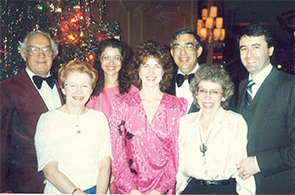
Several ARHP past presidents.
“In 2008 and 2009, the economy took a major downward flux, and a lot of people no longer had the opportunity to attend in-person meetings,” says Jan K. Richardson, PT, PhD, OCS, FAPTA (ARHP president, 2012–2013). “We were very creative with our education during that time and found ways to meet the needs of our members in a less expensive way.”
From this, came an ongoing and extensive collection of online education—including the Fundamentals of Rheumatology Course and the Advanced Rheumatology Course—that not only met the needs of ARHP members at that time, but continue to meet those needs today.
Although the Annual Meeting remains an educational highlight each year, the swift creation of these online courses sent a message to members that the ARHP will meet them where they are and ensure a variety of opportunities for professional development on numerous topics, at various price points and with minimal time and travel commitments. And ARHP members (as well as others outside the organization) have responded well—making these new educational offerings among the highest revenue generators for the ARHP today. In coming years, the ARHP will be adding to this online education portfolio, providing a larger selection of offerings in new formats and at different educational levels.
Lessons in Leadership
A key element to an invaluable ARHP member experience is volunteerism. No matter who you talk to—past presidents, committee chairs, advocates, etc.—they will almost assuredly note the return on investment in ARHP membership significantly increases the more involved a person becomes. This was true in the early days, and it remains true today.
“Volunteering provides excellent learning, professional and personal opportunities,” says Benjamin J. Smith, PA-C, DFAAPA (ARHP president, 2011–2012). These learned and developed skills are useful and applicable to the settings in which we find ourselves on a daily basis.”
For some presidents, leadership lessons were learned during turbulent times. Kathleen M. Ferrell, PT, MLA (ARHP president, 1985–1986), entered her presidency just as the ACR left the Arthritis Foundation and the ARHP decided to stay on. “This was a challenging period,” she says. “It was also a time when things needed to change, and we needed that change to be positive. As a result, I held the presidency for two years. I had really strong officers, and I felt we were able to come together as a group and guide the organization. In that time, we developed our first long-range plan, kick-started the effort to have our own journal and accomplished many other things that shaped us into more than a group of professionals that ‘just met.’”
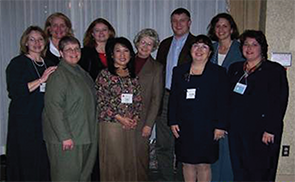
ARHP members lobbying on Capitol Hill.
For others, like Linda Ehrlich-Jones, PhD, RN (ARHP president, 2009–2010), it’s the natural progression into leadership that stands out. “My volunteerism in the ARHP provided me with opportunities to hone my leadership skills,” she recalls, “first on a committee, then as a part of a team, then as a committee chair and finally as part of the leadership. That really helped me both within the ARHP and in my career as a whole.”
Although volunteering has opened many doors and sharpened many skills for these past presidents, current ARHP President, Kamala M. Nola, PharmD, MS, brings the volunteer experience back to collaboration, noting, “It has helped me better understand the perspectives of the healthcare team—the different roles we play and how we each bring strength to the team.”
A Welcoming Mentorship Mentality
Before one is inclined to volunteer, they must first receive a warm welcome, and the ARHP’s inclusive culture and spirited outreach and mentorship does just that.
“In many professional associations, although it is very collaborative, it can be very competitive,” says Dr. Richardson. “I have never sensed that with the ARHP. The organization never did go down that path, and I credit the leadership and the staff for ensuring partnerships and an inclusive culture.”
Perhaps one of the best examples of this member-centric approach to education is the creation of online educational tools at a time when … budgets for education & travel were shrinking, & members were growing more accustomed to self-paced & self-guided learning.
For Dr. Ehrlich-Jones, the opportunity to be nurtured through the organization and then provide the same outreach to others has been refreshing. “I quickly realized that people will take you under their wing and mentor you,” she says. “I now find myself mentoring people and trying to get them involved. I know involvement as a volunteer is a good experience, and it is very exciting to me to be on the other end offering mentorship to those interested in volunteering.”
The opportunity to pay it forward was both professional and personal for Gail Kershner Riggs, MA, CHES (ARHP president, 1980–1981). Ms. Kershner Riggs was the first ARHP president with a rheumatic disease. As a volunteer, Ms. Kershner Riggs aimed to provide positive representation of someone with rheumatic disease while focusing on the work of the organization, such as introducing continuing education credits to the organization during her presidency. “There was so much that we were learning about rheumatic diseases at that time. It was an era when there was belief in an ‘RA personality,’ and use of terms like ‘grotesque crippling,’ and we had to do a lot of changing of our attitude,” she says.
The Next 50 Years
In 50 years, the ARHP has built a culture that welcomes newcomers and encourages those looking for education, growth and an opportunity to impact their profession. With this culture comes lifelong friendships and professional collaborations that ultimately shape patient care and research in rheumatology.
What will today’s members reflect on 50 years from now? How will the ARHP further shape the careers of its members and the care of their patients? And what will collaboration and integration look like in the future? Just as the work of yesterday set the stage for the achievements of today, the work of today will define the ARHP of tomorrow. And by all measures, the future looks bright.
Erin Latimer Meadows is a communications consultant and writer based in Atlanta. She is the principal consultant of Cause Collaboration LLC and works with organizations to help build their brands and meet their missions.

